Leadership - implications for Corporate Entrepreneurship and organisational innovation
VerifiedAdded on 2021/02/19
|10
|3159
|35
AI Summary
Contribute Materials
Your contribution can guide someone’s learning journey. Share your
documents today.

Leadership - implications for
Corporate Entrepreneurship and
organisational innovation
Corporate Entrepreneurship and
organisational innovation
Secure Best Marks with AI Grader
Need help grading? Try our AI Grader for instant feedback on your assignments.

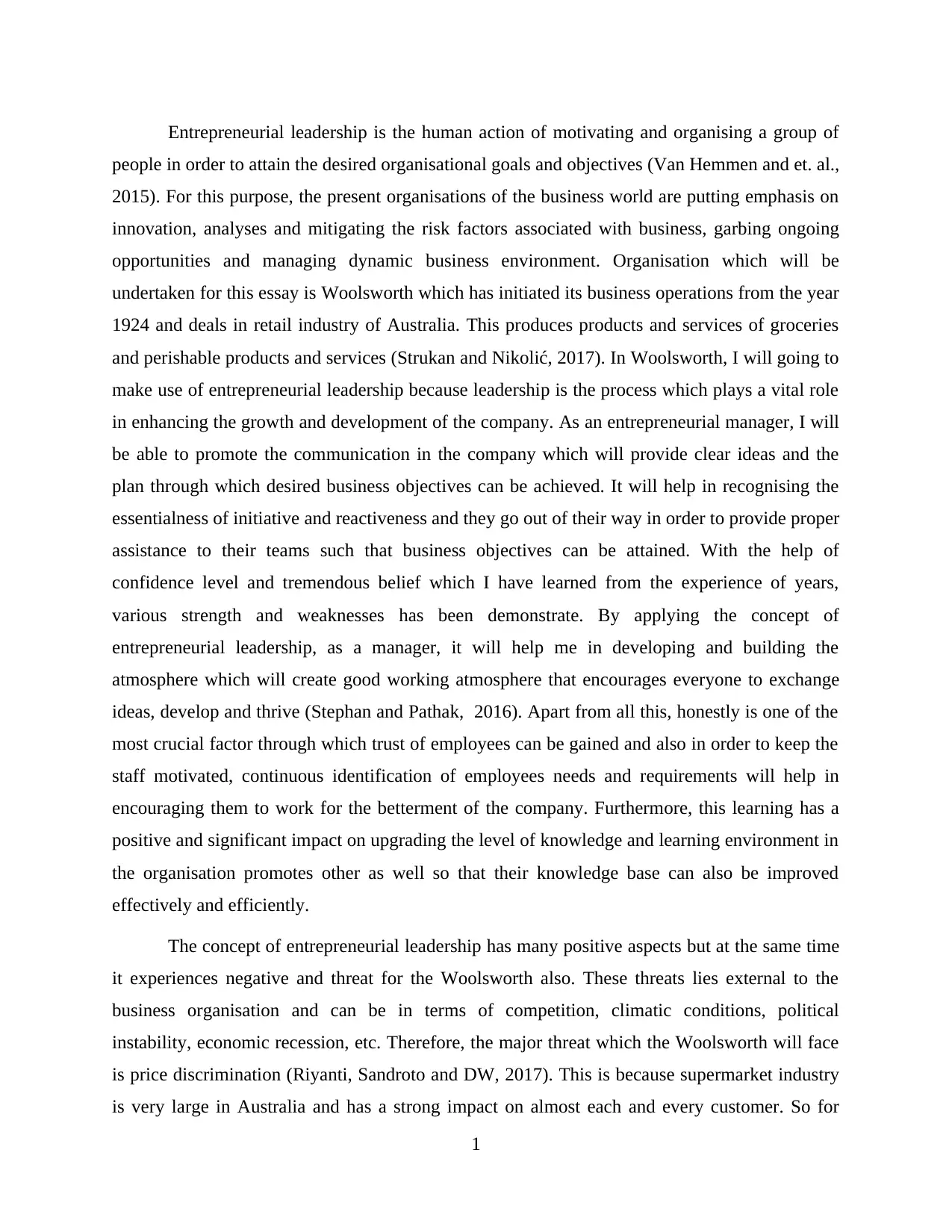
Entrepreneurial leadership is the human action of motivating and organising a group of
people in order to attain the desired organisational goals and objectives (Van Hemmen and et. al.,
2015). For this purpose, the present organisations of the business world are putting emphasis on
innovation, analyses and mitigating the risk factors associated with business, garbing ongoing
opportunities and managing dynamic business environment. Organisation which will be
undertaken for this essay is Woolsworth which has initiated its business operations from the year
1924 and deals in retail industry of Australia. This produces products and services of groceries
and perishable products and services (Strukan and Nikolić, 2017). In Woolsworth, I will going to
make use of entrepreneurial leadership because leadership is the process which plays a vital role
in enhancing the growth and development of the company. As an entrepreneurial manager, I will
be able to promote the communication in the company which will provide clear ideas and the
plan through which desired business objectives can be achieved. It will help in recognising the
essentialness of initiative and reactiveness and they go out of their way in order to provide proper
assistance to their teams such that business objectives can be attained. With the help of
confidence level and tremendous belief which I have learned from the experience of years,
various strength and weaknesses has been demonstrate. By applying the concept of
entrepreneurial leadership, as a manager, it will help me in developing and building the
atmosphere which will create good working atmosphere that encourages everyone to exchange
ideas, develop and thrive (Stephan and Pathak, 2016). Apart from all this, honestly is one of the
most crucial factor through which trust of employees can be gained and also in order to keep the
staff motivated, continuous identification of employees needs and requirements will help in
encouraging them to work for the betterment of the company. Furthermore, this learning has a
positive and significant impact on upgrading the level of knowledge and learning environment in
the organisation promotes other as well so that their knowledge base can also be improved
effectively and efficiently.
The concept of entrepreneurial leadership has many positive aspects but at the same time
it experiences negative and threat for the Woolsworth also. These threats lies external to the
business organisation and can be in terms of competition, climatic conditions, political
instability, economic recession, etc. Therefore, the major threat which the Woolsworth will face
is price discrimination (Riyanti, Sandroto and DW, 2017). This is because supermarket industry
is very large in Australia and has a strong impact on almost each and every customer. So for
1
people in order to attain the desired organisational goals and objectives (Van Hemmen and et. al.,
2015). For this purpose, the present organisations of the business world are putting emphasis on
innovation, analyses and mitigating the risk factors associated with business, garbing ongoing
opportunities and managing dynamic business environment. Organisation which will be
undertaken for this essay is Woolsworth which has initiated its business operations from the year
1924 and deals in retail industry of Australia. This produces products and services of groceries
and perishable products and services (Strukan and Nikolić, 2017). In Woolsworth, I will going to
make use of entrepreneurial leadership because leadership is the process which plays a vital role
in enhancing the growth and development of the company. As an entrepreneurial manager, I will
be able to promote the communication in the company which will provide clear ideas and the
plan through which desired business objectives can be achieved. It will help in recognising the
essentialness of initiative and reactiveness and they go out of their way in order to provide proper
assistance to their teams such that business objectives can be attained. With the help of
confidence level and tremendous belief which I have learned from the experience of years,
various strength and weaknesses has been demonstrate. By applying the concept of
entrepreneurial leadership, as a manager, it will help me in developing and building the
atmosphere which will create good working atmosphere that encourages everyone to exchange
ideas, develop and thrive (Stephan and Pathak, 2016). Apart from all this, honestly is one of the
most crucial factor through which trust of employees can be gained and also in order to keep the
staff motivated, continuous identification of employees needs and requirements will help in
encouraging them to work for the betterment of the company. Furthermore, this learning has a
positive and significant impact on upgrading the level of knowledge and learning environment in
the organisation promotes other as well so that their knowledge base can also be improved
effectively and efficiently.
The concept of entrepreneurial leadership has many positive aspects but at the same time
it experiences negative and threat for the Woolsworth also. These threats lies external to the
business organisation and can be in terms of competition, climatic conditions, political
instability, economic recession, etc. Therefore, the major threat which the Woolsworth will face
is price discrimination (Riyanti, Sandroto and DW, 2017). This is because supermarket industry
is very large in Australia and has a strong impact on almost each and every customer. So for
1

analysing the impact of price discrimination in the Australian market two different organisations
of chain of supermarket will be compared and they are Woolsworth and other one is Coles (Chan
and et. al., 2015). Price is one of the major factor which plays a vital role in growth and sale of
the business organisation. This is because customers are highly price centric and wants good
quality products at lower prices. In general, majority of the companies tends to follow the
concept of price discrimination and it becomes a major problem because it hinder the
competition. The price discrimination is the business practice in which business organisation
sells the similar products at different prices to different customers (Renko and et. al., 2015). If
Woolsworth will apply this practice then some customers may be left with the feeling of
dissatisfaction for paying higher prices for the products compared to the Coles which
discriminates their products prices in comparison to the competitors. It is one of the major issues
and threat for the companies all over the world. By adopting this practice, it will leads to
exploitation of the customers and they may develop poor word of mouth and also leads to
switching the brand which has been selling the products at low prices. This further leads to hustle
and bustle in the customers because they feel cheated and organisations are charging higher
prices for the particular section of the society in order to attain the business goals and objectives
(Lewis, 2015). By discriminating the prices of the products, it will have overall impact on the
economy of the country and business organisation. Customer will shift to the other brands and
this could lead to negativity or loses for the company. Furthermore, as a manager I will use
different methods of price discrimination in different markets. Where the customer base is high, I
will sell the products at higher prices and the place where customer base is low, the products will
be sold at comparatively lower prices. All this will have poor impact on the growth and
development of the Woolsworth as compares to Coles. This will directly affect the level of
competetion and provides the Coles to maximise the customer base (Leitch and Volery, 2017).
As a manager in Woolsworth, I have been analysed from above analysis, that there are
various situations present in business environment, that may impact on current as well as future
profitability. It mainly includes the price discrimination concept, where customers get easily
more attracted towards those stores that offer them same product or alternatives on heavy
discounts or price rates (Galloway, Kapasi and Sang, 2015). In this regard, to manage the
situations and make innovative improvement in business, it has been analysed that
entrepreneurial leadership will help in accelerating more changes in business, for achievement of
2
of chain of supermarket will be compared and they are Woolsworth and other one is Coles (Chan
and et. al., 2015). Price is one of the major factor which plays a vital role in growth and sale of
the business organisation. This is because customers are highly price centric and wants good
quality products at lower prices. In general, majority of the companies tends to follow the
concept of price discrimination and it becomes a major problem because it hinder the
competition. The price discrimination is the business practice in which business organisation
sells the similar products at different prices to different customers (Renko and et. al., 2015). If
Woolsworth will apply this practice then some customers may be left with the feeling of
dissatisfaction for paying higher prices for the products compared to the Coles which
discriminates their products prices in comparison to the competitors. It is one of the major issues
and threat for the companies all over the world. By adopting this practice, it will leads to
exploitation of the customers and they may develop poor word of mouth and also leads to
switching the brand which has been selling the products at low prices. This further leads to hustle
and bustle in the customers because they feel cheated and organisations are charging higher
prices for the particular section of the society in order to attain the business goals and objectives
(Lewis, 2015). By discriminating the prices of the products, it will have overall impact on the
economy of the country and business organisation. Customer will shift to the other brands and
this could lead to negativity or loses for the company. Furthermore, as a manager I will use
different methods of price discrimination in different markets. Where the customer base is high, I
will sell the products at higher prices and the place where customer base is low, the products will
be sold at comparatively lower prices. All this will have poor impact on the growth and
development of the Woolsworth as compares to Coles. This will directly affect the level of
competetion and provides the Coles to maximise the customer base (Leitch and Volery, 2017).
As a manager in Woolsworth, I have been analysed from above analysis, that there are
various situations present in business environment, that may impact on current as well as future
profitability. It mainly includes the price discrimination concept, where customers get easily
more attracted towards those stores that offer them same product or alternatives on heavy
discounts or price rates (Galloway, Kapasi and Sang, 2015). In this regard, to manage the
situations and make innovative improvement in business, it has been analysed that
entrepreneurial leadership will help in accelerating more changes in business, for achievement of
2
Secure Best Marks with AI Grader
Need help grading? Try our AI Grader for instant feedback on your assignments.
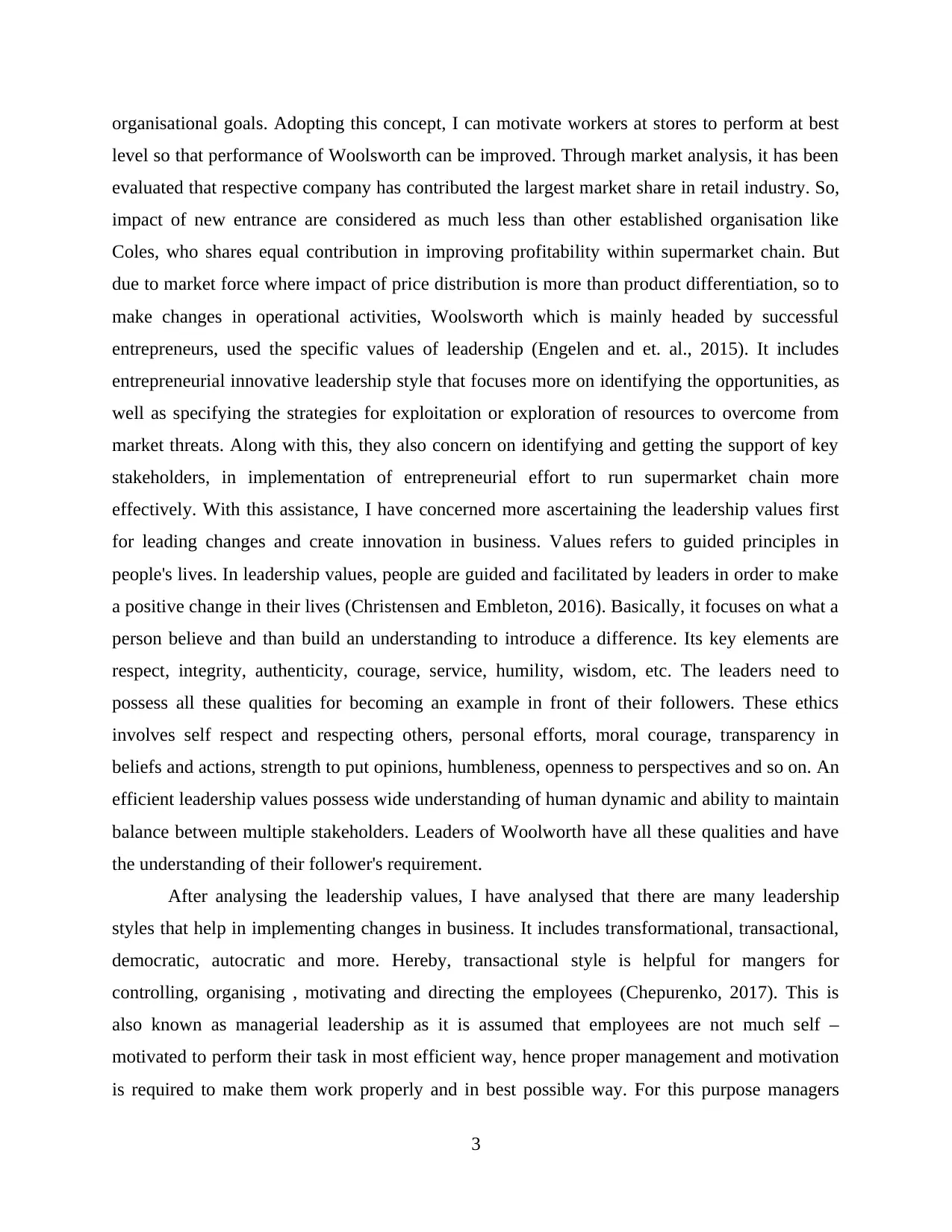
organisational goals. Adopting this concept, I can motivate workers at stores to perform at best
level so that performance of Woolsworth can be improved. Through market analysis, it has been
evaluated that respective company has contributed the largest market share in retail industry. So,
impact of new entrance are considered as much less than other established organisation like
Coles, who shares equal contribution in improving profitability within supermarket chain. But
due to market force where impact of price distribution is more than product differentiation, so to
make changes in operational activities, Woolsworth which is mainly headed by successful
entrepreneurs, used the specific values of leadership (Engelen and et. al., 2015). It includes
entrepreneurial innovative leadership style that focuses more on identifying the opportunities, as
well as specifying the strategies for exploitation or exploration of resources to overcome from
market threats. Along with this, they also concern on identifying and getting the support of key
stakeholders, in implementation of entrepreneurial effort to run supermarket chain more
effectively. With this assistance, I have concerned more ascertaining the leadership values first
for leading changes and create innovation in business. Values refers to guided principles in
people's lives. In leadership values, people are guided and facilitated by leaders in order to make
a positive change in their lives (Christensen and Embleton, 2016). Basically, it focuses on what a
person believe and than build an understanding to introduce a difference. Its key elements are
respect, integrity, authenticity, courage, service, humility, wisdom, etc. The leaders need to
possess all these qualities for becoming an example in front of their followers. These ethics
involves self respect and respecting others, personal efforts, moral courage, transparency in
beliefs and actions, strength to put opinions, humbleness, openness to perspectives and so on. An
efficient leadership values possess wide understanding of human dynamic and ability to maintain
balance between multiple stakeholders. Leaders of Woolworth have all these qualities and have
the understanding of their follower's requirement.
After analysing the leadership values, I have analysed that there are many leadership
styles that help in implementing changes in business. It includes transformational, transactional,
democratic, autocratic and more. Hereby, transactional style is helpful for mangers for
controlling, organising , motivating and directing the employees (Chepurenko, 2017). This is
also known as managerial leadership as it is assumed that employees are not much self –
motivated to perform their task in most efficient way, hence proper management and motivation
is required to make them work properly and in best possible way. For this purpose managers
3
level so that performance of Woolsworth can be improved. Through market analysis, it has been
evaluated that respective company has contributed the largest market share in retail industry. So,
impact of new entrance are considered as much less than other established organisation like
Coles, who shares equal contribution in improving profitability within supermarket chain. But
due to market force where impact of price distribution is more than product differentiation, so to
make changes in operational activities, Woolsworth which is mainly headed by successful
entrepreneurs, used the specific values of leadership (Engelen and et. al., 2015). It includes
entrepreneurial innovative leadership style that focuses more on identifying the opportunities, as
well as specifying the strategies for exploitation or exploration of resources to overcome from
market threats. Along with this, they also concern on identifying and getting the support of key
stakeholders, in implementation of entrepreneurial effort to run supermarket chain more
effectively. With this assistance, I have concerned more ascertaining the leadership values first
for leading changes and create innovation in business. Values refers to guided principles in
people's lives. In leadership values, people are guided and facilitated by leaders in order to make
a positive change in their lives (Christensen and Embleton, 2016). Basically, it focuses on what a
person believe and than build an understanding to introduce a difference. Its key elements are
respect, integrity, authenticity, courage, service, humility, wisdom, etc. The leaders need to
possess all these qualities for becoming an example in front of their followers. These ethics
involves self respect and respecting others, personal efforts, moral courage, transparency in
beliefs and actions, strength to put opinions, humbleness, openness to perspectives and so on. An
efficient leadership values possess wide understanding of human dynamic and ability to maintain
balance between multiple stakeholders. Leaders of Woolworth have all these qualities and have
the understanding of their follower's requirement.
After analysing the leadership values, I have analysed that there are many leadership
styles that help in implementing changes in business. It includes transformational, transactional,
democratic, autocratic and more. Hereby, transactional style is helpful for mangers for
controlling, organising , motivating and directing the employees (Chepurenko, 2017). This is
also known as managerial leadership as it is assumed that employees are not much self –
motivated to perform their task in most efficient way, hence proper management and motivation
is required to make them work properly and in best possible way. For this purpose managers
3
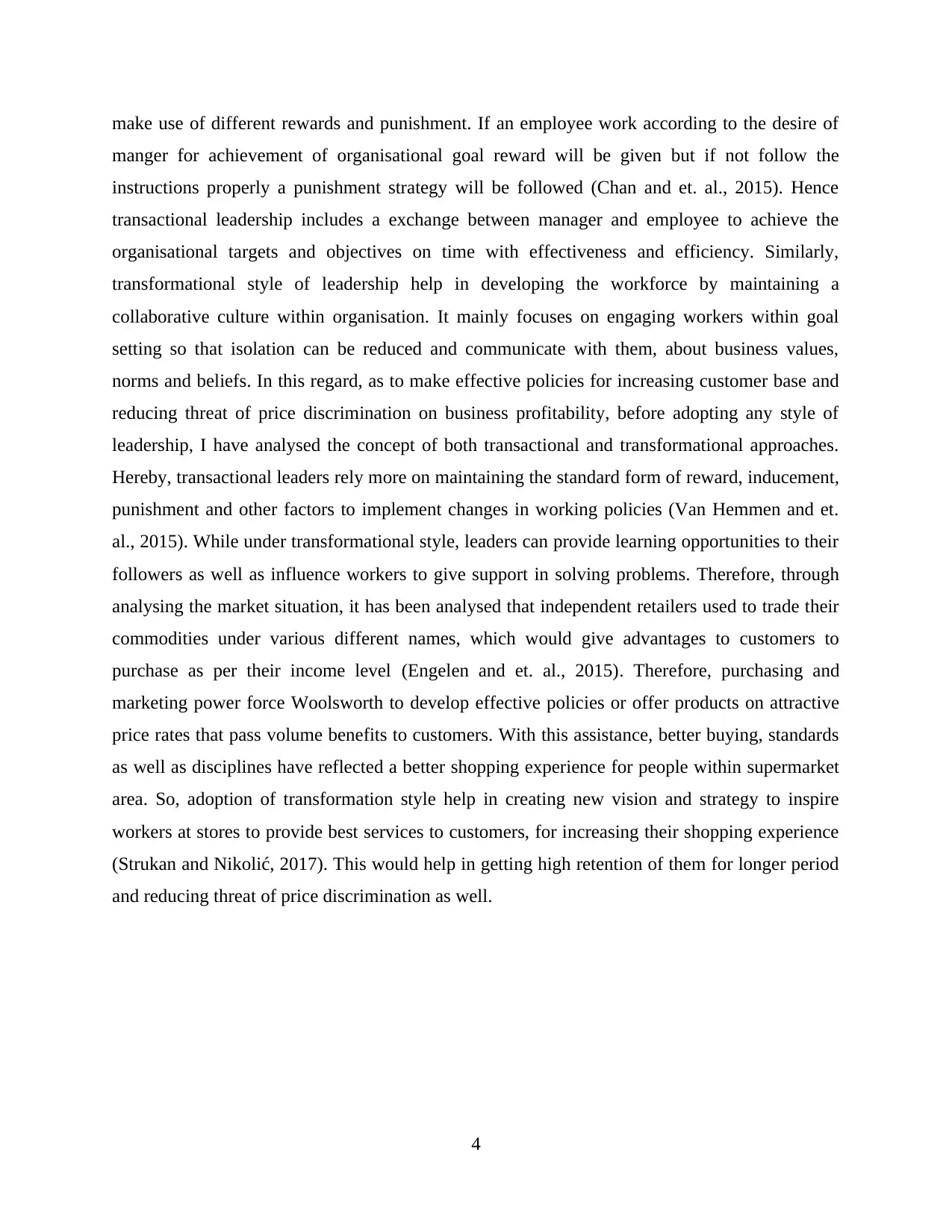
make use of different rewards and punishment. If an employee work according to the desire of
manger for achievement of organisational goal reward will be given but if not follow the
instructions properly a punishment strategy will be followed (Chan and et. al., 2015). Hence
transactional leadership includes a exchange between manager and employee to achieve the
organisational targets and objectives on time with effectiveness and efficiency. Similarly,
transformational style of leadership help in developing the workforce by maintaining a
collaborative culture within organisation. It mainly focuses on engaging workers within goal
setting so that isolation can be reduced and communicate with them, about business values,
norms and beliefs. In this regard, as to make effective policies for increasing customer base and
reducing threat of price discrimination on business profitability, before adopting any style of
leadership, I have analysed the concept of both transactional and transformational approaches.
Hereby, transactional leaders rely more on maintaining the standard form of reward, inducement,
punishment and other factors to implement changes in working policies (Van Hemmen and et.
al., 2015). While under transformational style, leaders can provide learning opportunities to their
followers as well as influence workers to give support in solving problems. Therefore, through
analysing the market situation, it has been analysed that independent retailers used to trade their
commodities under various different names, which would give advantages to customers to
purchase as per their income level (Engelen and et. al., 2015). Therefore, purchasing and
marketing power force Woolsworth to develop effective policies or offer products on attractive
price rates that pass volume benefits to customers. With this assistance, better buying, standards
as well as disciplines have reflected a better shopping experience for people within supermarket
area. So, adoption of transformation style help in creating new vision and strategy to inspire
workers at stores to provide best services to customers, for increasing their shopping experience
(Strukan and Nikolić, 2017). This would help in getting high retention of them for longer period
and reducing threat of price discrimination as well.
4
manger for achievement of organisational goal reward will be given but if not follow the
instructions properly a punishment strategy will be followed (Chan and et. al., 2015). Hence
transactional leadership includes a exchange between manager and employee to achieve the
organisational targets and objectives on time with effectiveness and efficiency. Similarly,
transformational style of leadership help in developing the workforce by maintaining a
collaborative culture within organisation. It mainly focuses on engaging workers within goal
setting so that isolation can be reduced and communicate with them, about business values,
norms and beliefs. In this regard, as to make effective policies for increasing customer base and
reducing threat of price discrimination on business profitability, before adopting any style of
leadership, I have analysed the concept of both transactional and transformational approaches.
Hereby, transactional leaders rely more on maintaining the standard form of reward, inducement,
punishment and other factors to implement changes in working policies (Van Hemmen and et.
al., 2015). While under transformational style, leaders can provide learning opportunities to their
followers as well as influence workers to give support in solving problems. Therefore, through
analysing the market situation, it has been analysed that independent retailers used to trade their
commodities under various different names, which would give advantages to customers to
purchase as per their income level (Engelen and et. al., 2015). Therefore, purchasing and
marketing power force Woolsworth to develop effective policies or offer products on attractive
price rates that pass volume benefits to customers. With this assistance, better buying, standards
as well as disciplines have reflected a better shopping experience for people within supermarket
area. So, adoption of transformation style help in creating new vision and strategy to inspire
workers at stores to provide best services to customers, for increasing their shopping experience
(Strukan and Nikolić, 2017). This would help in getting high retention of them for longer period
and reducing threat of price discrimination as well.
4
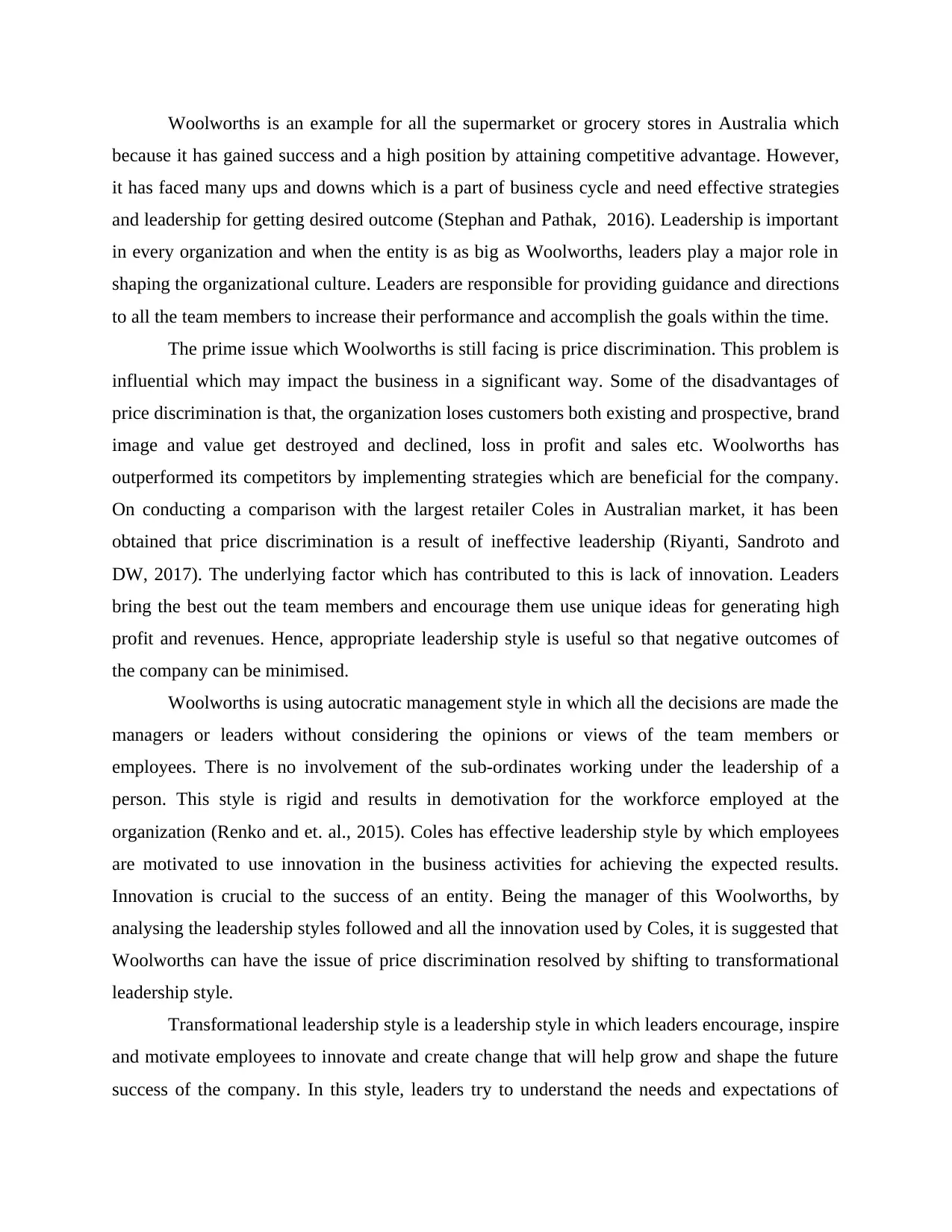
Woolworths is an example for all the supermarket or grocery stores in Australia which
because it has gained success and a high position by attaining competitive advantage. However,
it has faced many ups and downs which is a part of business cycle and need effective strategies
and leadership for getting desired outcome (Stephan and Pathak, 2016). Leadership is important
in every organization and when the entity is as big as Woolworths, leaders play a major role in
shaping the organizational culture. Leaders are responsible for providing guidance and directions
to all the team members to increase their performance and accomplish the goals within the time.
The prime issue which Woolworths is still facing is price discrimination. This problem is
influential which may impact the business in a significant way. Some of the disadvantages of
price discrimination is that, the organization loses customers both existing and prospective, brand
image and value get destroyed and declined, loss in profit and sales etc. Woolworths has
outperformed its competitors by implementing strategies which are beneficial for the company.
On conducting a comparison with the largest retailer Coles in Australian market, it has been
obtained that price discrimination is a result of ineffective leadership (Riyanti, Sandroto and
DW, 2017). The underlying factor which has contributed to this is lack of innovation. Leaders
bring the best out the team members and encourage them use unique ideas for generating high
profit and revenues. Hence, appropriate leadership style is useful so that negative outcomes of
the company can be minimised.
Woolworths is using autocratic management style in which all the decisions are made the
managers or leaders without considering the opinions or views of the team members or
employees. There is no involvement of the sub-ordinates working under the leadership of a
person. This style is rigid and results in demotivation for the workforce employed at the
organization (Renko and et. al., 2015). Coles has effective leadership style by which employees
are motivated to use innovation in the business activities for achieving the expected results.
Innovation is crucial to the success of an entity. Being the manager of this Woolworths, by
analysing the leadership styles followed and all the innovation used by Coles, it is suggested that
Woolworths can have the issue of price discrimination resolved by shifting to transformational
leadership style.
Transformational leadership style is a leadership style in which leaders encourage, inspire
and motivate employees to innovate and create change that will help grow and shape the future
success of the company. In this style, leaders try to understand the needs and expectations of
because it has gained success and a high position by attaining competitive advantage. However,
it has faced many ups and downs which is a part of business cycle and need effective strategies
and leadership for getting desired outcome (Stephan and Pathak, 2016). Leadership is important
in every organization and when the entity is as big as Woolworths, leaders play a major role in
shaping the organizational culture. Leaders are responsible for providing guidance and directions
to all the team members to increase their performance and accomplish the goals within the time.
The prime issue which Woolworths is still facing is price discrimination. This problem is
influential which may impact the business in a significant way. Some of the disadvantages of
price discrimination is that, the organization loses customers both existing and prospective, brand
image and value get destroyed and declined, loss in profit and sales etc. Woolworths has
outperformed its competitors by implementing strategies which are beneficial for the company.
On conducting a comparison with the largest retailer Coles in Australian market, it has been
obtained that price discrimination is a result of ineffective leadership (Riyanti, Sandroto and
DW, 2017). The underlying factor which has contributed to this is lack of innovation. Leaders
bring the best out the team members and encourage them use unique ideas for generating high
profit and revenues. Hence, appropriate leadership style is useful so that negative outcomes of
the company can be minimised.
Woolworths is using autocratic management style in which all the decisions are made the
managers or leaders without considering the opinions or views of the team members or
employees. There is no involvement of the sub-ordinates working under the leadership of a
person. This style is rigid and results in demotivation for the workforce employed at the
organization (Renko and et. al., 2015). Coles has effective leadership style by which employees
are motivated to use innovation in the business activities for achieving the expected results.
Innovation is crucial to the success of an entity. Being the manager of this Woolworths, by
analysing the leadership styles followed and all the innovation used by Coles, it is suggested that
Woolworths can have the issue of price discrimination resolved by shifting to transformational
leadership style.
Transformational leadership style is a leadership style in which leaders encourage, inspire
and motivate employees to innovate and create change that will help grow and shape the future
success of the company. In this style, leaders try to understand the needs and expectations of
Paraphrase This Document
Need a fresh take? Get an instant paraphrase of this document with our AI Paraphraser
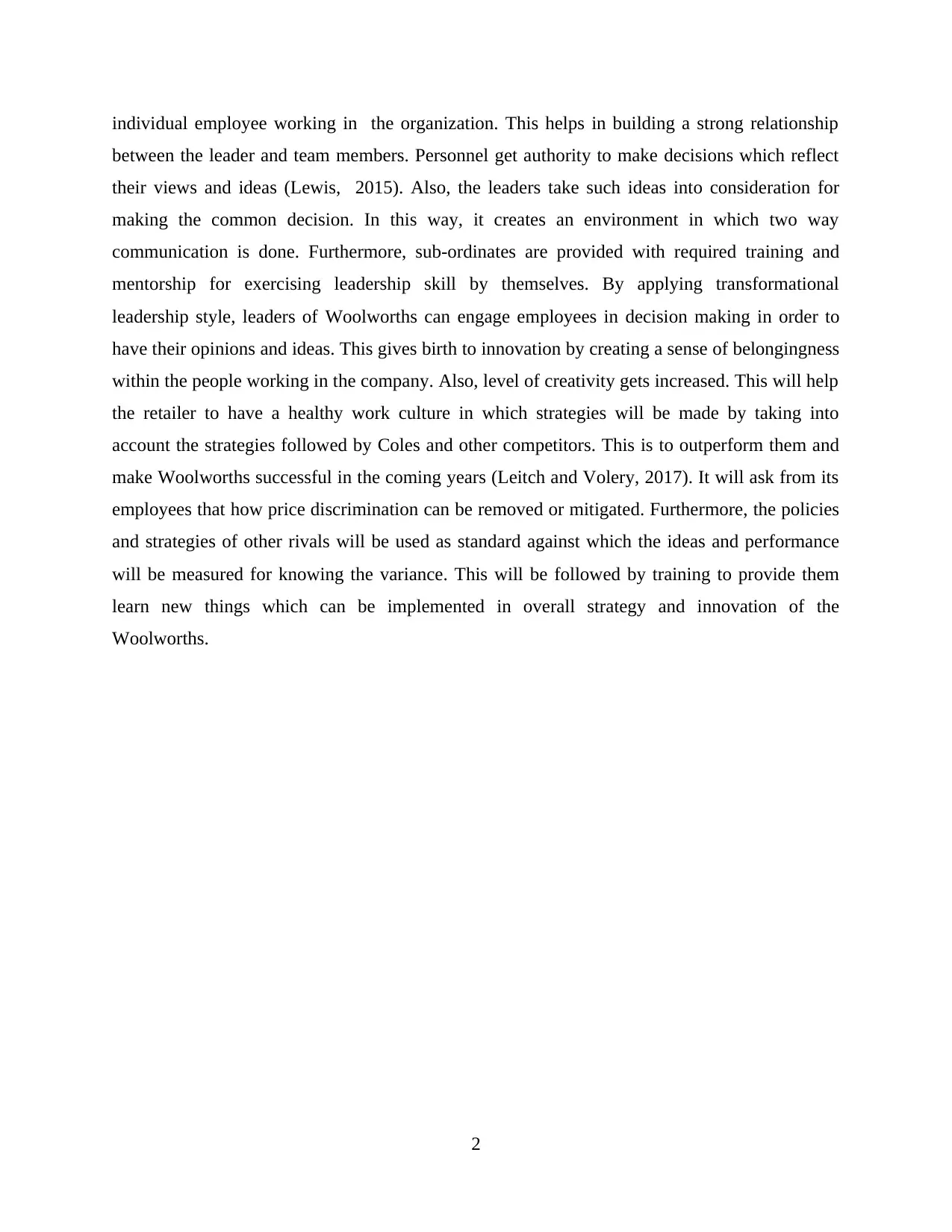
individual employee working in the organization. This helps in building a strong relationship
between the leader and team members. Personnel get authority to make decisions which reflect
their views and ideas (Lewis, 2015). Also, the leaders take such ideas into consideration for
making the common decision. In this way, it creates an environment in which two way
communication is done. Furthermore, sub-ordinates are provided with required training and
mentorship for exercising leadership skill by themselves. By applying transformational
leadership style, leaders of Woolworths can engage employees in decision making in order to
have their opinions and ideas. This gives birth to innovation by creating a sense of belongingness
within the people working in the company. Also, level of creativity gets increased. This will help
the retailer to have a healthy work culture in which strategies will be made by taking into
account the strategies followed by Coles and other competitors. This is to outperform them and
make Woolworths successful in the coming years (Leitch and Volery, 2017). It will ask from its
employees that how price discrimination can be removed or mitigated. Furthermore, the policies
and strategies of other rivals will be used as standard against which the ideas and performance
will be measured for knowing the variance. This will be followed by training to provide them
learn new things which can be implemented in overall strategy and innovation of the
Woolworths.
2
between the leader and team members. Personnel get authority to make decisions which reflect
their views and ideas (Lewis, 2015). Also, the leaders take such ideas into consideration for
making the common decision. In this way, it creates an environment in which two way
communication is done. Furthermore, sub-ordinates are provided with required training and
mentorship for exercising leadership skill by themselves. By applying transformational
leadership style, leaders of Woolworths can engage employees in decision making in order to
have their opinions and ideas. This gives birth to innovation by creating a sense of belongingness
within the people working in the company. Also, level of creativity gets increased. This will help
the retailer to have a healthy work culture in which strategies will be made by taking into
account the strategies followed by Coles and other competitors. This is to outperform them and
make Woolworths successful in the coming years (Leitch and Volery, 2017). It will ask from its
employees that how price discrimination can be removed or mitigated. Furthermore, the policies
and strategies of other rivals will be used as standard against which the ideas and performance
will be measured for knowing the variance. This will be followed by training to provide them
learn new things which can be implemented in overall strategy and innovation of the
Woolworths.
2
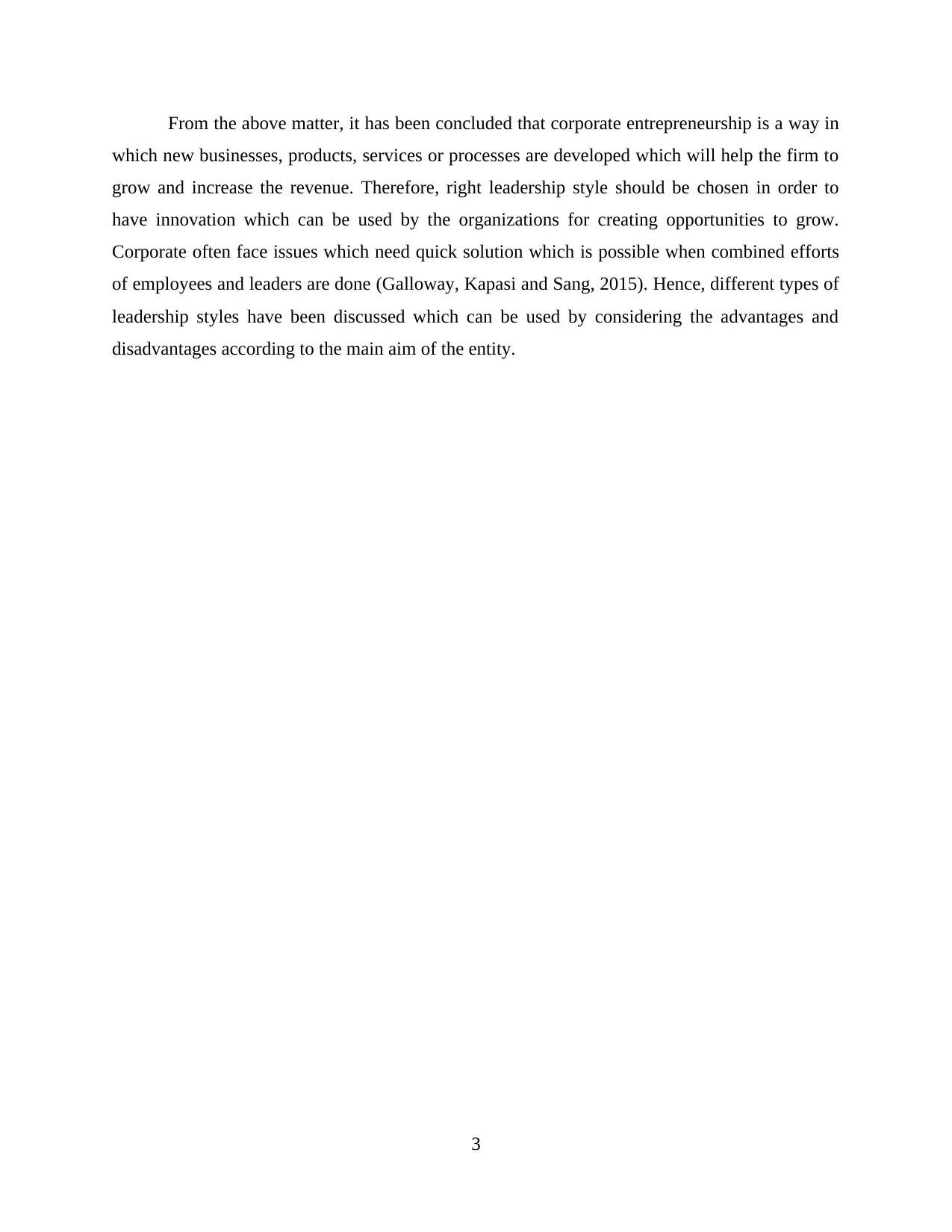
From the above matter, it has been concluded that corporate entrepreneurship is a way in
which new businesses, products, services or processes are developed which will help the firm to
grow and increase the revenue. Therefore, right leadership style should be chosen in order to
have innovation which can be used by the organizations for creating opportunities to grow.
Corporate often face issues which need quick solution which is possible when combined efforts
of employees and leaders are done (Galloway, Kapasi and Sang, 2015). Hence, different types of
leadership styles have been discussed which can be used by considering the advantages and
disadvantages according to the main aim of the entity.
3
which new businesses, products, services or processes are developed which will help the firm to
grow and increase the revenue. Therefore, right leadership style should be chosen in order to
have innovation which can be used by the organizations for creating opportunities to grow.
Corporate often face issues which need quick solution which is possible when combined efforts
of employees and leaders are done (Galloway, Kapasi and Sang, 2015). Hence, different types of
leadership styles have been discussed which can be used by considering the advantages and
disadvantages according to the main aim of the entity.
3
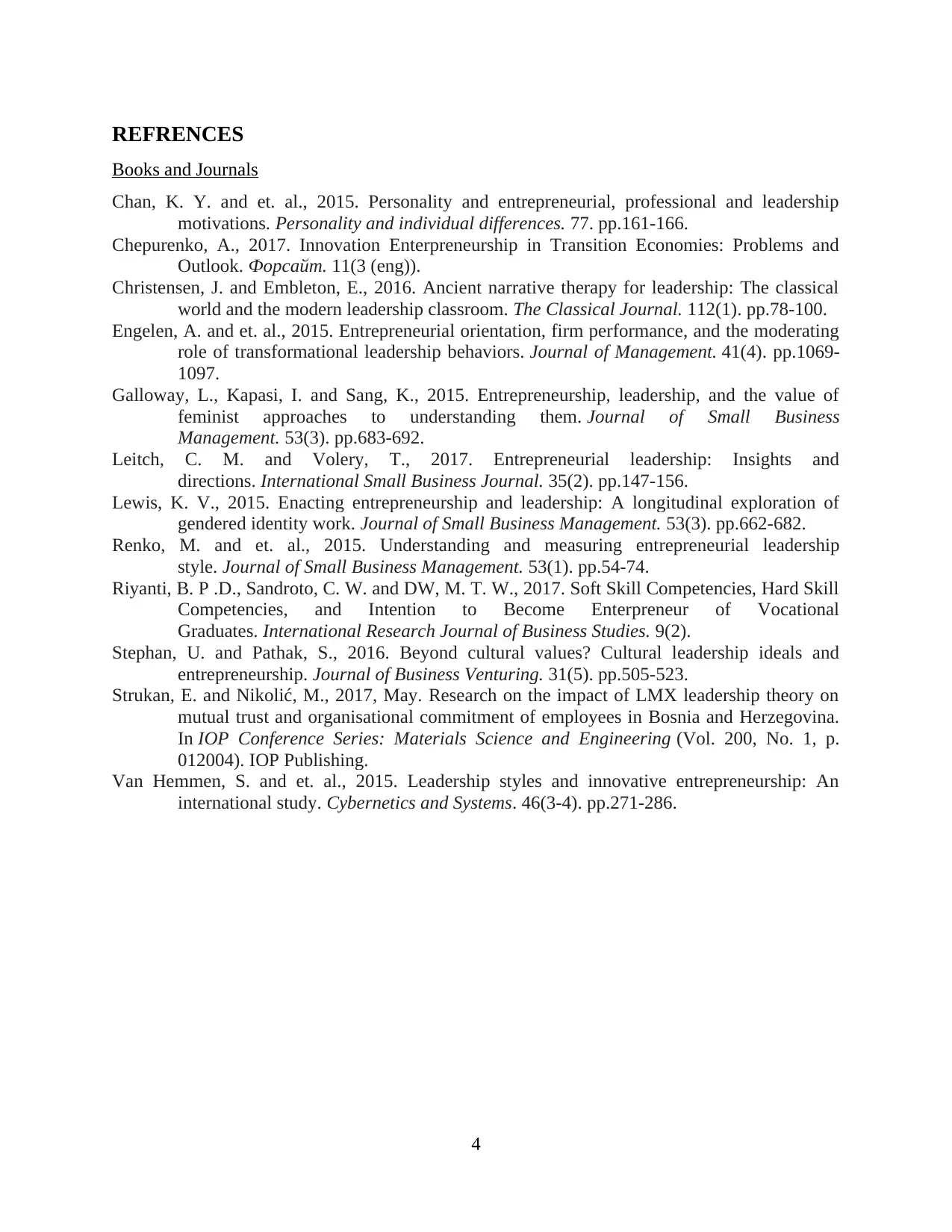
REFRENCES
Books and Journals
Chan, K. Y. and et. al., 2015. Personality and entrepreneurial, professional and leadership
motivations. Personality and individual differences. 77. pp.161-166.
Chepurenko, A., 2017. Innovation Enterpreneurship in Transition Economies: Problems and
Outlook. Форсайт. 11(3 (eng)).
Christensen, J. and Embleton, E., 2016. Ancient narrative therapy for leadership: The classical
world and the modern leadership classroom. The Classical Journal. 112(1). pp.78-100.
Engelen, A. and et. al., 2015. Entrepreneurial orientation, firm performance, and the moderating
role of transformational leadership behaviors. Journal of Management. 41(4). pp.1069-
1097.
Galloway, L., Kapasi, I. and Sang, K., 2015. Entrepreneurship, leadership, and the value of
feminist approaches to understanding them. Journal of Small Business
Management. 53(3). pp.683-692.
Leitch, C. M. and Volery, T., 2017. Entrepreneurial leadership: Insights and
directions. International Small Business Journal. 35(2). pp.147-156.
Lewis, K. V., 2015. Enacting entrepreneurship and leadership: A longitudinal exploration of
gendered identity work. Journal of Small Business Management. 53(3). pp.662-682.
Renko, M. and et. al., 2015. Understanding and measuring entrepreneurial leadership
style. Journal of Small Business Management. 53(1). pp.54-74.
Riyanti, B. P .D., Sandroto, C. W. and DW, M. T. W., 2017. Soft Skill Competencies, Hard Skill
Competencies, and Intention to Become Enterpreneur of Vocational
Graduates. International Research Journal of Business Studies. 9(2).
Stephan, U. and Pathak, S., 2016. Beyond cultural values? Cultural leadership ideals and
entrepreneurship. Journal of Business Venturing. 31(5). pp.505-523.
Strukan, E. and Nikolić, M., 2017, May. Research on the impact of LMX leadership theory on
mutual trust and organisational commitment of employees in Bosnia and Herzegovina.
In IOP Conference Series: Materials Science and Engineering (Vol. 200, No. 1, p.
012004). IOP Publishing.
Van Hemmen, S. and et. al., 2015. Leadership styles and innovative entrepreneurship: An
international study. Cybernetics and Systems. 46(3-4). pp.271-286.
4
Books and Journals
Chan, K. Y. and et. al., 2015. Personality and entrepreneurial, professional and leadership
motivations. Personality and individual differences. 77. pp.161-166.
Chepurenko, A., 2017. Innovation Enterpreneurship in Transition Economies: Problems and
Outlook. Форсайт. 11(3 (eng)).
Christensen, J. and Embleton, E., 2016. Ancient narrative therapy for leadership: The classical
world and the modern leadership classroom. The Classical Journal. 112(1). pp.78-100.
Engelen, A. and et. al., 2015. Entrepreneurial orientation, firm performance, and the moderating
role of transformational leadership behaviors. Journal of Management. 41(4). pp.1069-
1097.
Galloway, L., Kapasi, I. and Sang, K., 2015. Entrepreneurship, leadership, and the value of
feminist approaches to understanding them. Journal of Small Business
Management. 53(3). pp.683-692.
Leitch, C. M. and Volery, T., 2017. Entrepreneurial leadership: Insights and
directions. International Small Business Journal. 35(2). pp.147-156.
Lewis, K. V., 2015. Enacting entrepreneurship and leadership: A longitudinal exploration of
gendered identity work. Journal of Small Business Management. 53(3). pp.662-682.
Renko, M. and et. al., 2015. Understanding and measuring entrepreneurial leadership
style. Journal of Small Business Management. 53(1). pp.54-74.
Riyanti, B. P .D., Sandroto, C. W. and DW, M. T. W., 2017. Soft Skill Competencies, Hard Skill
Competencies, and Intention to Become Enterpreneur of Vocational
Graduates. International Research Journal of Business Studies. 9(2).
Stephan, U. and Pathak, S., 2016. Beyond cultural values? Cultural leadership ideals and
entrepreneurship. Journal of Business Venturing. 31(5). pp.505-523.
Strukan, E. and Nikolić, M., 2017, May. Research on the impact of LMX leadership theory on
mutual trust and organisational commitment of employees in Bosnia and Herzegovina.
In IOP Conference Series: Materials Science and Engineering (Vol. 200, No. 1, p.
012004). IOP Publishing.
Van Hemmen, S. and et. al., 2015. Leadership styles and innovative entrepreneurship: An
international study. Cybernetics and Systems. 46(3-4). pp.271-286.
4
1 out of 10
Related Documents
Your All-in-One AI-Powered Toolkit for Academic Success.
+13062052269
info@desklib.com
Available 24*7 on WhatsApp / Email
![[object Object]](/_next/static/media/star-bottom.7253800d.svg)
Unlock your academic potential
© 2024 | Zucol Services PVT LTD | All rights reserved.





